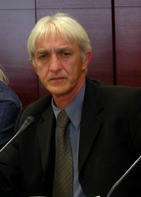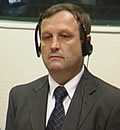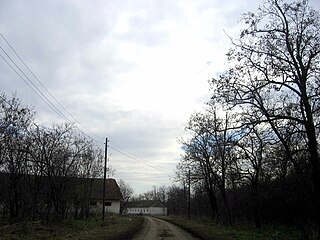
Milan Babić was a Croatian Serb politician and war criminal who served as the first president of the Republic of Serbian Krajina, a self-proclaimed state largely populated by Serbs of Croatia that wished to break away from Croatia during the Croatian War of Independence.

The Republic of Serbian Krajina or Serb Republic of Krajina, known as the Serbian Krajina or simply Krajina, was a self-proclaimed Serb proto-state, a territory within the newly independent Republic of Croatia, which it defied, and which was active during the Croatian War of Independence (1991–95). It was not recognized internationally. The name Krajina ("Frontier") was adopted from the historical Military Frontier of the Habsburg monarchy (Austria-Hungary), which had a substantial Serb population and existed up to the late 19th century. The RSK government waged a war for ethnic Serb independence from Croatia and unification with the Federal Republic of Yugoslavia and Republika Srpska.

Dragan Vasiljković, nicknamed Captain Dragan is a convicted war criminal and the former commander of a Serb paramilitary unit called the Knindže or during the Yugoslav Wars. In 2005, prosecutors in Croatia accused him of committing war crimes during the wars. A warrant for his arrest was subsequently issued by Interpol.

The Croatian War of Independence was fought from 1991 to 1995 between Croat forces loyal to the Government of Croatia—which had declared independence from the Socialist Federal Republic of Yugoslavia (SFRY)—and the Serb-controlled Yugoslav People's Army (JNA) and local Serb forces, with the JNA ending its combat operations in Croatia by 1992. In Croatia, the war is primarily referred to as the "Homeland War" and also as the "Greater-Serbian Aggression". In Serbian sources, "War in Croatia" and (rarely) "War in Krajina" are used.

The Trnopolje camp was an internment camp established by Bosnian Serb military and police authorities in the village of Trnopolje near Prijedor in northern Bosnia and Herzegovina, during the first months of the Bosnian War. Also variously termed a concentration camp, detainment camp, detention camp, prison, and ghetto, Trnopolje held between 4,000 and 7,000 Bosniak and Bosnian Croat inmates at any one time and served as a staging area for mass deportations, mainly of women, children, and elderly men. Between May and November 1992, an estimated 30,000 inmates passed through. Mistreatment was widespread and there were numerous instances of torture, rape, and killing; ninety inmates died.

Milan Martić is a Croatian Serb politician and war criminal who served as the president of the unrecognized Republic of Serbian Krajina between 1994 and 1995, during the Croatian War of Independence.

The Čelebići camp was a concentration camp run by joint Bosniak and Bosnian Croat forces during the Bosnian War where Serb prisoners were detained and subjected to murder, beatings, torture, sexual assaults and otherwise cruel and inhumane treatment. The facility was used by several units of the Bosnian Ministry of the Interior (MUP), Croatian Defence Council (HVO) and later the Bosnian Territorial Defence Forces (TO). It was located in Čelebići, a village in the central Bosnian municipality of Konjic.
Hazim Delić is a Bosnian former prison camp commander who served as the deputy commander of the Čelebići camp, a joint Bosniak and Bosnian Croat forces run prison camp, during the Bosnian War. The majority of the prisoners who were detained in the camp were men, captured during and after the military operations at Bradina and Donje Selo and their surrounding areas.
The Škabrnja massacre was the killing of 62 Croatian civilians and five prisoners of war by Serbian Autonomous Oblast Krajina Territorial Defence troops and the Yugoslav People's Army (JNA) in the villages of Škabrnja and Nadin east of Zadar on 18–19 November 1991, during the Croatian War of Independence. The massacre occurred shortly after an agreement to evacuate Zadar's JNA garrison following an increase in fighting between the Croatian National Guard and the JNA. Most of the killings were committed by SAO Krajina troops which followed the leading armoured JNA units fighting their way into Škabrnja on 18 November. During the initial attack, the attacking force employed a human shield of captured civilians forced to walk in front of armoured vehicles. Most of the civilian population fled the village and about 120–130 were captured by the JNA and detained in the village school and kindergarten. However, others who took shelter in basements were killed in or just outside their homes. A portion of those killed in the massacre were buried in a mass grave in Škabrnja, while dozens of bodies were turned over to Croatian authorities.
The Baćin massacre was the killing of 83 civilians just outside the village of Baćin, near Hrvatska Dubica, committed by Croatian Serb paramilitaries. The killings took place on 21 October 1991 during the Croatian War of Independence. Most of the civilians were Croats, but they also included two ethnic Serbs, taken from Hrvatska Dubica, Baćin and the nearby village of Cerovljani. The civilians were killed in the area of Krečane, at the very bank of the Una River, and their bodies were left unburied for two weeks. Most of them were subsequently bulldozed into a shallow mass grave, while a number of the bodies were thrown into the river.
Sremska Mitrovica Prison is the biggest prison in Serbia, consisting of two facilities. It is situated in Sremska Mitrovica, Vojvodina province. During the Yugoslavian Civil Wars it was used as a concentration camp for thousands of Croatian and Bosnian prisoners amidst allegations of torture, prisoner abuse and rape.

The Stajićevo camp was an agricultural farm in Stajićevo near Zrenjanin, Serbia where Croatian prisoners of war and civilians were kept by Serbian authorities. The camp also acted as a transit facility where prisoners were taken before being moved to the Sremska Mitrovica camp. Individual reports have said that 1500 people were held there. The ICTY's figure for the camp was 1700 detainees.
The Begejci camp was a detention camp established in September–October 1991 in Begejci near Zrenjanin, Serbia where Croatian prisoners of war and civilians were kept by Serbian authorities during the Croatian War of Independence. The detainees were mostly brought from Vukovar and some were later moved to other camps. At least three people are known to have died there. The camp was opened in the autumn of 1991, and held approximately 600 prisoners. The ICTY cited 260 detainees in its indictment against Slobodan Milošević.
The Velepromet camp was a detention facility established in the final days of the Battle of Vukovar during the Croatian War of Independence. The camp was set up by the Yugoslav People's Army (JNA), which shared control of the facility with Croatian Serb rebels. The facility, originally an industrial storage site, was located on the southern outskirts of the city of Vukovar, in close proximity to the JNA barracks. It consisted of eight warehouses surrounded by a wire fence, and was established on 16 November 1991, when the first detainees were brought there.

During the Bosnian War, there was an ethnic cleansing campaign committed by the Bosnian Serb political and military leadership – Army of the Republika Srpska, mostly against Bosniak and Croat civilians in the Prijedor region of Bosnia and Herzegovina in 1992 and 1993. The composition of non-Serbs was drastically reduced: out of a population of 50,000 Bosniaks and 6,000 Croats, only some 6,000 Bosniaks and 3,000 Croats remained in the municipality by the end of the war. After the Srebrenica massacre, Prijedor is the area with the second highest rate of civilian killings committed during the Bosnian War. According to the Sarajevo-based Research and Documentation Center (IDC), 4,868 people were killed or went missing in the Prijedor municipality during the war. Among them were 3,515 Bosniak civilians, 186 Croat civilians and 78 Serb civilians. As of October 2013, 96 mass graves have been located and around 2,100 victims have been identified, largely by DNA analysis.
The Dalj massacre was the killing of 56 or 57 Croats in Dalj, Croatia on 1 August 1991, during the Croatian War of Independence. In addition to civilian victims, the figure includes 20 Croatian policemen, 15 Croatian National Guard troops and four civil defencemen who had been defending the police station and water supply building in the village. While some of the policemen and the ZNG troops died in combat, those who surrendered were killed after they became prisoners of war. They tried to fight off an attack by the Croatian Serb SAO Eastern Slavonia, Baranja and Western Syrmia Territorial Defence Forces, supported by the Yugoslav People's Army and the Serb Volunteer Guard paramilitaries. The SAO SBWS was declared an autonomous territory in eastern Croatia following the Battle of Borovo Selo just to the south of Dalj.
The Prosecutor v. Milan Martić was a case brought before the International Criminal Tribunal for the Former Yugoslavia concerning war crimes committed during the Croatian War of Independence against non-Serbs.

Serbia was involved in the Yugoslav Wars, which took place between 1991 and 1999—the war in Slovenia, the war in Croatia, the war in Bosnia, and Kosovo. From 1991 to 1997, Slobodan Milošević was the President of Serbia. Serbia was part of the Federal Republic of Yugoslavia (FRY). The International Criminal Tribunal for the Former Yugoslavia (ICTY) has established that Milošević was in control of Serb forces in Bosnia and Herzegovina and Croatia during the wars which were fought there from 1991 to 1995.
Operation Stinger was an offensive undertaken by the forces of the SAO Krajina, an unrecognized Croatian Serb region opposing the Republic of Croatia, against positions held by the Croatian police in the region of Banovina on 26–27 July 1991, during the Croatian War of Independence. It was primarily aimed at police stations in Glina and Kozibrod, as well as police-held positions in a string of villages between the town of Dvor and Kozibrod. In addition to Glina and Kozibrod, heavy fighting took place in the village of Struga, north of Dvor, where Croatian Serb forces employed a human shield consisting of Croat civilians taken from their homes in Struga and the nearby village of Zamlača.
The Grubori massacre was the mass murder of six Serb civilians from the village of Grubori, near Knin, on 25 August 1995 by members of the Croatian Army (HV) in the aftermath of Operation Storm. The massacre was listed in the ICTY's indictment of Croatian wartime generals Ante Gotovina, Ivan Čermak and Mladen Markač.











